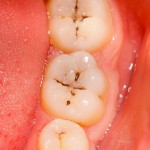
Caries is the world’s most common preventable disease and occlusal surfaces are one of the most common sites. When diagnosed early the caries process can be stabilised and reversed so in addition to visual examination and number of diagnostic tools including radiography, light fluorescence, fibre-optic transillumination and quantitative light-induced fluorescence have been developed and tested.
The aim of this review was to assess the diagnostic performance of commonly used methods for occlusal caries diagnoses.
Methods
Searches were conducted in the Medline/PubMed, and Embase databases for in-vitro and in-vivo diagnostic studies in human permanent molar teeth and published in English. The following index tests, visual examination (VE), conventional bitewing radiography (BWR), digital BWR, Laser fluorescence (LF) measurements, fibre-optic transillumination (FOTI) and quantitative light-induced fluorescence (QLF) were included. Histology was the reference standard for in-vitro studies and cavity preparation or biopsy for in-vivo studies. Two reviewers independently selected studies and extracted data. Risk of bias was assessed by two reviewers independently using a specially develop set of criteria derived from the QUADAS tool. Pooled estimates of sensitivity (SE), specificity (SP), diagnostic odds ratio (DOR) and areas under ROC curves (AUCs) were calculated.
Results
- 29 in-vitro and 8 in-vivo studies were included.
- Sensitivity, specificity and diagnostic odds ratios for caries detection in dentine for in-vitro studies are shown in the table below.
| No. of studies | Sensitivity (95%CI) | Specificity (95%CI) | Diagnostic odds ratio (95%CI) | |
| Visual exam | 8 | 0.46 (0.20–0.73) | 0.87 (0.72–0.95) | 5.93 (3.11–11.31) |
| Conventional BWR (D-speed) | 1 | 0.42 (0.18–0.69) | 0.73 (0.53–0.87) | 1.94 (0.46–8.17) |
| Conventional BWR (E-speed) | 2 | 0.48 (0.21–0.77) | 0.95 (0.53–0.997) | 10.69 (3.67–31.15) |
| Conventional BWR (F-speed) | 2 | 0.50 (0.22–0.79) | 0.97 (0.71–0.998) | 23.60 (8.28–67.24) |
| Digital BWR (Phosphor plates) | 2 | 0.48 (0.24–0.73) | 0.95 (0.59–0.995) | 15.57 (0.47–515.27) |
| LF 2095 | 7 | 0.68 (0.54–0.79) | 0.78 (0.68–0.85) | 8.01 (4.04–15.88) |
| LF Pen 2190 | 4 | 0.63 (0.37–0.83) | 0.77 (0.62–0.88) | 5.85 (1.77–19.30) |
| FOTI | 2 | 0.49 (0.20–0.79) | 0.97 (0.89–0.994) | 37.77 (13.69–104.19) |
- No studies for QLF were included.
Conclusions
The authors concluded: –
There is an overall need for high-quality, well-designed and standardised studies on the detection, diagnosis, assessment and/or monitoring of occlusal surface caries. This need must be emphasized for diagnostic studies under in vivo conditions due to the limited number of clinical trials and the documented heterogeneity between published reports. When considering the meta-analytic results, VE, BWR and LF provide acceptable measures for their diagnostic performance on occlusal surfaces. Again, the present results should be interpreted with caution with respect to the limited data in many diagnostic categories.
Comments
Cochrane Oral Health have recently completed a suite of reviews looking at caries diagnosis (Dental Elf – 16th Jun 2021). The Cochrane review focussed on the individual diagnostic method (visual, light-based tests, fluorescence, electrical conductance and radiographs) while this review considered diagnosis for the type of tooth surface. The reviewers excluded studies with a high risk of bias and assessed the diagnostic test performance at three levels although we have only shown the findings for dentine caries detection for the in-vitro studies above. Only single studies were included for some of the diagnostic tests and a there is a high degree of spectrum bias which may influence the findings. As with the Cochrane reviews most of the included studies were conducted in-vitro which needs to be taken into consideration when translating the findings to patients in a clinical environment. Both this review and the Cochrane reviews highlight the need to conduct well designed and well reported in-vivo studies of adequate size using common standards for both existing and developing diagnostic techniques.
Links
Primary Paper
Kapor S, Rankovic MJ, Khazaei Y, Crispin A, Schüler I, Krause F, Lussi A, Neuhaus K, Eggmann F, Michou S, Ekstrand K, Huysmans MC, Kühnisch J. Systematic review and meta-analysis of diagnostic methods for occlusal surface caries. Clin Oral Investig. 2021 Aug;25(8):4801-4815. doi: 10.1007/s00784-021-04024-1. Epub 2021 Jun 14. PMID: 34128130; PMCID: PMC8342337.
Other references
Dental Elf – 16th Jun 2021
